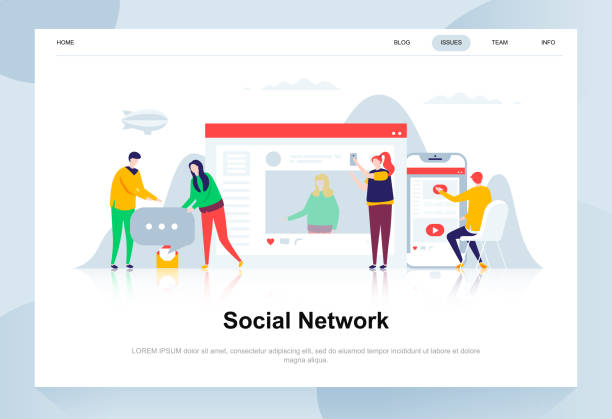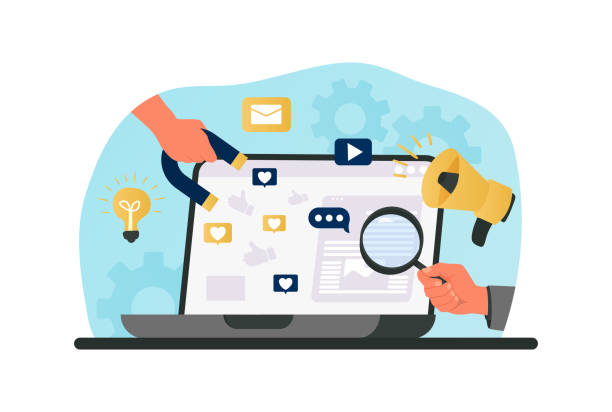Introduction to the Importance of Secure Website Design in Today’s World

In the current digital age, secure website design is no longer an option, but an undeniable necessity.
Websites act as a digital storefront for businesses and interaction platforms for individuals, and any shortcoming in #site_security can have irreparable consequences.
Loss of #user_trust, serious financial damage, and even violation of data privacy laws, are just some of the risks resulting from neglecting this vital issue.
Users expect their personal and financial information to be kept in a secure environment, and any negligence in this area can permanently tarnish a brand’s reputation.
Therefore, the main goal in any website design project should be built on security principles from the outset.
This chapter descriptively and educationally examines the reasons for the importance of this topic and clarifies its various dimensions.
In a world where cyberattacks are increasingly complex and frequent, secure website design is a protective shield against growing threats.
Intruders look for weaknesses in systems to gain access to sensitive information, take websites offline, or even use them for malicious activities.
This includes the theft of credit card information, passwords, identity information, and other confidential data, which can lead to fraud and significant financial losses.
For businesses, a cyberattack can lead to loss of customers, reduced revenue, and huge costs for rebuilding and repairing damages.
Even a simple personal website or blog is no exception and can be targeted by hackers.
Therefore, education and awareness of secure website design solutions are essential for all developers, website administrators, and even ordinary users.
This awareness helps us to take a preventive approach and adopt necessary measures before an incident occurs.
Creating a security culture in the development process from the initial stages to launch and maintenance, lays the foundation for a resilient and reliable website.
Ultimately, secure website design not only means protecting data and systems, but also creating a trustworthy platform for users and preserving your business’s online reputation.
This comprehensive approach will guarantee long-term success in the digital world.
Is your current e-commerce website not generating the expected sales for you?
RasaWeb is an expert in professional e-commerce website design!
✅ Attractive and user-friendly site aimed at increasing sales
✅ High speed and security for an ideal shopping experience⚡ Get a free consultation on online store design with RasaWeb!
Basic Principles of Secure Website Design and Key Factors

On the path to achieving a secure website design and reliable, adhering to basic principles and paying attention to key factors is of high importance.
These principles form the cornerstone of any successful security system and act as a roadmap for developers and website administrators.
One of the most important factors is secure coding.
#secure_coding means using best practices and standards when writing website code to prevent unintended security holes.
This includes input validation, proper use of security functions, and avoiding vulnerable coding patterns.
Another vital factor is #regular_software_updates; all website components, including the Content Management System (CMS), plugins, themes, and even the server operating system, must be continuously updated.
Many cyberattacks occur through known vulnerabilities in older software versions that can be prevented with a simple update.
Furthermore, access control and proper user identity management are also an integral part of a secure website design.
Choosing a secure and reliable hosting is also very important in secure website design.
The hosting service provider must provide strong security measures such as advanced firewalls, intrusion detection systems, and protection against DDoS attacks.
Using strong and unique passwords for all user accounts, including administrative accounts, and enabling two-factor authentication (2FA) wherever possible, creates an additional layer of protection.
The importance of #regular_data_backup should also not be overlooked.
Having up-to-date and recoverable backup versions ensures that in case of an attack or data loss, information can be restored and the site returned to normal.
This backup process should be automated and stored in a secure location separate from the main server.
Finally, performing regular penetration tests and vulnerability assessments can help identify weaknesses before they are discovered by attackers.
These analytical and guiding approaches enable developers to approach secure website design with a more comprehensive view and ensure the robustness of their infrastructures.
By adhering to these principles, a website with a high level of security and trust can be launched and maintained.
Combating Common Vulnerabilities in Secure Website Design

In the process of secure website design, identifying and combating common web vulnerabilities is one of the most important steps.
Hackers mainly exploit known weaknesses in programming or website configurations.
One of the most common vulnerabilities is SQL Injection, where an attacker attempts to access or modify the database by injecting malicious SQL code into program inputs.
To prevent this attack, using Prepared Statements (Prepared Statements) or strict input validation is essential.
Another vulnerability is #XSS (Cross-Site Scripting) which allows an attacker to inject malicious client-side code (usually JavaScript) into web pages.
These codes can steal user information or perform unwanted operations.
The solution includes Sanitization (Sanitization) or filtering all user inputs before displaying them on the page and using Content Security Policy (CSP).
#CSRF (Cross-Site Request Forgery) also allows an attacker to send unauthorized requests on behalf of an authenticated user to the victim’s website.
Protection against CSRF is usually done by using anti-CSRF tokens or checking the Referer header.
This chapter analytically and descriptively examines these vulnerabilities and solutions for combating them in secure website design.
The #OWASP_Top_10 list, as a reputable reference, annually publishes 10 of the most dangerous web security vulnerabilities and provides practical guidance for combating them.
Other important vulnerabilities include broken authentication and session management (Broken Authentication and Session Management), which can lead to session hijacking or bypassing the login process; and security misconfiguration (Security Misconfiguration) which results from errors in server, framework, or application settings.
Sensitive Data Exposure (Sensitive Data Exposure) is also one of the issues that occurs if confidential user information is not properly encrypted or protected.
For secure website design, strong encryption must be used for data in transit and data at rest.
This continuous and conscious combating of vulnerabilities is an integral part of the development process.
Implementing these security measures provides a strong preventive approach that will prevent many common attacks and significantly contribute to the stability and trustworthiness of the website.
| Vulnerability | Brief Description | Preventive Solutions in Secure Website Design |
|---|---|---|
| SQL Injection | Injecting malicious SQL code to access or modify the database. | Using Prepared Statements, input validation, using ORMs. |
| Cross-Site Scripting (XSS) | Injecting malicious scripts into web pages to attack users. | Input validation and sanitization, using CSP. |
| Cross-Site Request Forgery (CSRF) | Executing unwanted requests on behalf of an authenticated user. | Using CSRF tokens, checking the Referer header. |
| Broken Authentication | Weaknesses in authentication mechanisms (e.g., weak passwords, session management). | Enforcing strong passwords, using MFA, secure session management. |
| Sensitive Data Exposure | Unintended disclosure of sensitive user information (credit card, personal information). | Encrypting data in transit and at rest, retaining minimum necessary data. |
The Role of SSL/TLS Certificates in Enhancing Website Security

In today’s world, any discussion about secure website design would be incomplete without addressing the critical role of SSL/TLS certificates.
These certificates are the backbone of #data_encryption and authentication on the web and their presence means data transmission via the secure HTTPS protocol.
When a website uses HTTPS, the communication between the user’s browser and the web server is encrypted.
This encryption prevents eavesdropping, tampering, or forgery of information during transmission.
Imagine entering sensitive information such as usernames, passwords, or credit card details; without SSL/TLS, this information would be sent as plain text over the network, and anyone could access it.
But with an SSL/TLS certificate, this information is converted into unreadable code before transmission, which can only be decrypted by the recipient.
This chapter educationally and professionally examines the function and importance of these certificates in secure website design.
Different types of SSL/TLS certificates exist, including: DV (Domain Validation) which only validates the domain, OV (Organization Validation) which also validates the organization’s identity, and EV (Extended Validation) which provides the highest level of validation and displays the company name in the browser’s address bar.
The higher the level of validation, the more user trust in the website will be.
In addition to the security aspect, using HTTPS has other benefits as well.
From a Search Engine Optimization (SEO) perspective, Google and other search engines prefer websites with HTTPS in their rankings.
This means that secure website design with HTTPS can help improve your website’s visibility in search results.
Also, many new web features like Service Workers and Geolocation are only usable over HTTPS connections.
Correct installation and configuration of these certificates is a very important step towards increasing overall website security and gaining user trust.
Ensuring the certificate is up-to-date and using newer versions of TLS (such as TLS 1.3) are also important points to consider.
These measures form the cornerstone of a secure website design and secure communication in the online space.
Are you losing business opportunities due to an outdated company website? RasaWeb solves the problem of not attracting potential customers through your website forever!
✅ Increases your brand’s credibility.
✅ Helps attract targeted customers.
⚡ Contact RasaWeb for a free website design consultation!
Protecting User Data and Ensuring Privacy in Secure Website Design

At the heart of every secure website design process, #user_data_protection and #privacy_observance are located.
With increasing public awareness of the importance of personal data, stricter laws and regulations such as GDPR (General Data Protection Regulation) in Europe and CCPA (California Consumer Privacy Act) in America have been passed, violations of which can lead to heavy penalties.
These laws require websites to have full transparency regarding how user data is collected, stored, processed, and used.
Therefore, privacy policies and cookie policies must be clearly drafted and easily accessible to users.
One of the key principles in this area is the principle of “data minimization”; meaning collect only the data necessary for providing services and no more.
This chapter descriptively and instructively addresses various aspects of privacy protection within the framework of secure website design.
To ensure data protection, all sensitive user information must be stored encrypted, both in the database and during transmission.
Using strong and up-to-date encryption algorithms for this purpose is vital.
Also, implementing precise access control mechanisms for information, so that only authorized individuals can access specific data, is of high importance.
This includes Role-Based Access Control.
Users should be given the ability to easily access their information, modify it, or even request its deletion (right to be forgotten).
Attention to security at different layers of the application, from the user interface to the database and server, is essential to prevent accidental or intentional disclosure of information.
This includes protecting server logs, configuration files, and other sensitive resources.
Educating staff and the development team about best practices for data protection and the importance of privacy is also an important step.
Secure website design is not just about preventing external attacks, but also about creating a trustworthy environment where users feel secure and their privacy respected.
This approach forms the foundation of a stable and successful relationship with your audience.
Monitoring and Intrusion Detection Tools and Techniques

After implementing initial measures in secure website design, the next critical step is continuous monitoring and detection of suspicious activities.
A secure website is one that is not only designed to be resistant to attacks, but also capable of quickly identifying and reacting to any attempted intrusion or unusual activities.
In this regard, #security_monitoring_tools and #Intrusion_Detection_Systems (IDS) play a pivotal role.
These tools continuously monitor network traffic, server logs, and user behavior to identify unusual patterns or signs of an attack.
For example, repeated failed login attempts, unauthorized access to files, or sudden changes in website traffic can be indicators of an attack.
This chapter professionally and informatively introduces tools and techniques that assist you in #secure_website_design.
One of the most important tools in this area is Web Application Firewall (WAF).
WAF acts as a protective layer between the web server and the internet and analyzes HTTP requests before they reach the website.
This firewall can identify and block common web attacks such as SQL Injection and XSS.
Also, using SIEM (Security Information and Event Management) systems to collect and analyze logs from various sources across the network, provides a comprehensive view of the security status and helps security analysts quickly identify and respond to threats.
Vulnerability scanner tools also regularly scan the website to discover security weaknesses.
These scanners can uncover security holes in code, server configuration, or software in use.
Monitoring website performance and traffic can also reveal signs of DDoS (Distributed Denial of Service) attacks, where attackers try to take down the website by sending a huge volume of traffic.
The combined use of these tools and techniques provides a comprehensive approach to secure website design and maintaining its stability against increasing threats.
This continuous monitoring is a vital part of any website’s defense strategy.
Planning for Security Incident Response and Data Recovery

Even with the best secure website design measures and thorough precautions, it is possible for a security incident to occur.
No system is 100% impenetrable, and preparing for the worst-case scenario is a critical part of cybersecurity strategy.
Therefore, #incident_response_planning (Incident Response Plan) and having a #data_recovery_strategy (Disaster Recovery Plan) are essential for any website that seeks secure website design.
These plans help teams act in an organized and efficient manner in case of an attack, prevent damage from spreading, and restore the website to normal operation as quickly as possible.
An incident response plan includes stages of identification, containment, eradication, recovery, and lessons learned.
This chapter analytically and instructively examines the importance and method of developing these plans within the framework of secure website design.
The first step in incident response is identification and confirmation of intrusion.
This includes detecting suspicious activities through monitoring tools and logs.
After confirmation, the containment phase begins, aiming to prevent damage from spreading to other parts of the system, such as disconnecting infected sections or isolating attacked servers.
The eradication phase involves removing the source of intrusion (such as malware or unauthorized access) and ensuring the attacker can no longer access the system.
Then comes data recovery.
In this phase, the website is restored from valid and clean backups, and all systems are securely re-launched.
#regular_backup and tested, are critical factors for success in this phase.
It must be ensured that backup copies are kept in secure and separate locations from the main server.
Data recovery does not just mean restoring data, but also restoring the full functionality of the website and related systems.
Finally, the lessons learned phase involves a thorough review of the incident, identifying root causes, and updating security protocols and measures to prevent similar incidents from recurring.
Regular practice of these plans helps teams perform optimally during a crisis and comprehensively improve the secure website design process.
| Stage | Description | Key Considerations in Secure Website Design |
|---|---|---|
| Identification | Detecting and confirming the occurrence of a security incident. | Using strong monitoring systems (SIEM, IDS), comprehensive logs. |
| Containment | Preventing damage spread and isolating affected sections. | Having predefined plans for disconnection, isolating servers. |
| Eradication | Removing the source of intrusion (malware, unauthorized access) and closing vulnerabilities. | Detailed vulnerability analysis, removing all attacker access points. |
| Recovery | Restoring systems and data to normal operational state. | Regular and tested backups, emergency recovery strategy (DRP). |
| Lessons Learned | Analyzing the incident, identifying root causes, and improving future security measures. | Holding post-incident meetings, updating policies and procedures. |
User Education and the Importance of Awareness in Secure Website Design

One of the often-overlooked dimensions in secure website design is the #human_factor.
Even with the strongest firewalls and most advanced encryption systems, if end-users or even website administrators are not aware of basic cybersecurity principles, the website will remain vulnerable.
#Phishing attacks, social engineering, and malware often target users and, by deceiving them, open the way for system penetration.
Therefore, user education and continuous awareness, are an essential component of any comprehensive secure website design strategy.
These trainings should include topics such as how to identify suspicious emails, the importance of choosing strong and unique passwords, and the dangers of clicking on unknown links.
This chapter educationally and entertainingly covers the importance of this topic and how to implement it.
To increase user awareness, various methods can be used.
Holding workshops, preparing engaging and understandable educational materials (such as infographics or short videos), and sending regular informational emails, can all be effective.
Emphasis on the importance of using strong passwords and changing them regularly, and also enabling two-factor authentication (MFA) for all accounts, should be a priority.
Users should be encouraged to report any suspicious activity and be skeptical of any requests for personal information through unofficial channels.
Websites can also help users make more informed decisions by providing clear security messages when they interact with forms or sensitive information.
For example, when changing a password, provide guidelines for choosing a strong password.
This awareness is not limited to end-users; the development and website management team should also regularly receive security training to stay informed about the latest threats and best practices in secure website design.
By investing in education and awareness, we can strengthen the “weakest link” in the security chain and have significantly more secure websites.
This proactive and comprehensive approach plays an important role in the success of secure website design strategies.
Are you worried your company’s old website will drive away new customers? RasaWeb solves this problem by designing modern and efficient company websites.
✅ Increases your brand’s credibility.
✅ Helps attract targeted customers.
⚡ Call RasaWeb for a free website design consultation!
The Future of Secure Website Design and New Challenges

The digital world is rapidly evolving, and with the emergence of new technologies, unprecedented challenges are also appearing in the field of secure website design.
While today we focus on protecting against traditional attacks, the future of web security will face threats that require innovative and advanced solutions.
#Artificial_intelligence and #machine_learning, which themselves have high potential in enhancing security, can also be used by attackers to carry out more complex and automated attacks, such as targeted phishing with highly convincing content generation or automated vulnerability identification.
This creates a #questionable_content in the field of security: how can we stay ahead in this digital arms race?
This chapter analytically examines these challenges and future trends in secure website design.
One of the biggest future challenges is Internet of Things (IoT) security.
With the proliferation of internet-connected devices, websites and platforms must be able to manage secure communications with these devices, which itself can create new entry points for attacks.
Furthermore, quantum computing has the potential to break many current encryption algorithms that form the basis of today’s cybersecurity.
Although this technology is still in its early stages, secure website design teams should already be thinking about post-quantum cryptography.
Blockchain technology, with its immutable and distributed features, can also provide new solutions for security and privacy, especially in the areas of authentication and data management.
However, its widespread implementation and ensuring its own security also pose specific challenges.
The need for self-healing systems that can automatically identify and fix vulnerabilities, or predictive security systems that can anticipate attacks before they occur, are other trends on the horizon for secure website design.
This continuous evolution requires ongoing research and development, international cooperation, and an innovative approach to maintaining a secure cyberspace.
Conclusion and Key Recommendations for Sustainable Secure Website Design

Throughout this article, we examined various aspects of secure website design from basic principles to future challenges.
From the importance of secure coding and regular updates to the vital role of SSL/TLS certificates and the necessity of planning for security incident response, all these factors combine to form a secure and reliable website.
To achieve a sustainable secure website design, it is necessary to consider security not as a one-time project, but as a continuous and dynamic process.
This means continuous monitoring, ongoing updates, and adaptability to evolving threats.
In this chapter, we descriptively and instructively summarize key recommendations for maintaining your website’s security.
The first recommendation is the Security by Design approach.
Instead of adding security as a post-development phase, security should be considered from the very beginning in all stages of the software development life cycle.
This includes training the development team, using secure frameworks and libraries, and performing security tests at each stage.
Second, never forget regular updates and patching.
This is an ongoing activity that should be included in your website maintenance plan.
Third, implement regular and tested backups.
Having a strong data recovery strategy can make the difference between a disaster and a minor interruption in critical situations.
Fourth, use appropriate security tools, including WAF, IDS/IPS, and vulnerability scanners.
These tools help you identify, prevent, and respond to threats.
Fifth, take user education and awareness seriously.
The human factor can be both the strongest defense and the most vulnerable point of a system.
Finally, always be prepared and have an incident response plan that is regularly practiced and updated.
By following these key recommendations, you can have a stable and reliable website and ensure that secure website design is always a priority.
This comprehensive approach will guarantee your security and success in the digital world.
Frequently Asked Questions
| Question | Answer |
|---|---|
| 1. What does secure website design mean? | Secure website design means creating a website that is resistant to cyberattacks and protects user and server information. |
| 2. Why is security important in website design? | To prevent data breaches, protect user privacy, maintain user trust, and avoid financial and reputational losses. |
| 3. What are the most common web vulnerabilities? | SQL Injection, Cross-Site Scripting (XSS), Cross-Site Request Forgery (CSRF), Broken Authentication, and Security Misconfiguration. |
| 4. How can SQL injection be prevented? | By using Prepared Statements / Parameterized Queries, ORMs, and Input Validation. |
| 5. What is the role of HTTPS and SSL/TLS in website security? | HTTPS, using the SSL/TLS protocol, encrypts the communication between the user’s browser and the server, preventing data eavesdropping and tampering. |
| 6. What measures should be taken to prevent XSS attacks? | Input validation, Output Encoding to prevent malicious code execution, and using Content Security Policy (CSP). |
| 7. What does a strong password policy include? | Enforcing the use of long passwords, a combination of uppercase and lowercase letters, numbers, and special characters, and preventing reuse. |
| 8. How does Two-Factor Authentication (2FA) help with security? | Even if the user’s password is compromised, the attacker cannot access the account without access to the second authentication factor (such as an SMS code or an app). |
| 9. What is a Web Application Firewall (WAF) and what is its use? | A WAF is a firewall that monitors and filters HTTP traffic between a web application and the internet to prevent common web attacks like SQL Injection and XSS. |
| 10. Why are regular updates of software and libraries important? | Updates often include security patches to fix discovered vulnerabilities. Failure to update can expose the site to new attacks. |
And other services of RasaWeb Advertising Agency in the field of advertising
Smart Customer Journey Map: Professional optimization for customer acquisition using key page optimization.
Smart Conversion Rate Optimization: A professional solution for user engagement with a focus on custom programming.
Smart Customer Journey Map: Professional optimization for customer behavior analysis using SEO-driven content strategy.
Smart Marketing Automation: Professional optimization for digital branding using attractive UI design.
Smart Advertorial: A creative platform for improving customer acquisition with marketing automation.
And over hundreds of other services in the field of internet advertising, advertising consultation and organizational solutions
Internet Advertising | Advertising Strategy | Advertorial
Resources
Principles of Secure Website Design
Importance of SSL Certificate on Website
? Are you ready to transform your business in the digital world? Rasaweb Afarin, a leading digital marketing agency, with comprehensive services including custom website design, SEO, and content marketing, provides innovative and targeted solutions for your growth and success. With us, have a powerful and influential online presence and achieve your business goals.
📍 Tehran, Mirdamad Street, next to Central Bank, Kazeroon Janubi Alley, Ramin Alley, No. 6



